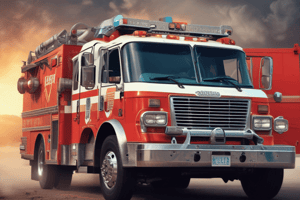Podcast
Questions and Answers
In complex special rescue operations, what is the MOST critical factor in ensuring the safety and efficiency of both the rescue team and the patient during the 'Disentanglement' phase?
In complex special rescue operations, what is the MOST critical factor in ensuring the safety and efficiency of both the rescue team and the patient during the 'Disentanglement' phase?
- Relying solely on the rescuer with the most experience to make on-the-spot decisions, thereby circumventing the need for constant communication and reassessment.
- Thorough assessment and mitigation of potential hazards, such as undeployed airbags or compromised structural elements, combined with continuous patient stabilization. (correct)
- Using the most powerful hydraulic tools available to quickly cut through any obstructions, regardless of the potential vibrations and secondary injuries they might cause.
- Prioritizing speed in extricating the patient, even if it means slightly compromising the spinal immobilization protocols, to minimize overall time spent on scene.
A specialized rescue team is responding to a motor vehicle accident involving a vehicle submerged in rapidly flowing, icy water. Considering the unique challenges presented by this environment, which modification to the standard 'Removal' phase is MOST critical for ensuring patient and rescuer safety?
A specialized rescue team is responding to a motor vehicle accident involving a vehicle submerged in rapidly flowing, icy water. Considering the unique challenges presented by this environment, which modification to the standard 'Removal' phase is MOST critical for ensuring patient and rescuer safety?
- Immediately winching the vehicle to shore without stabilizing it in the water, prioritizing speed of removal over potential further injury to the patient.
- Utilizing only non-specialized personnel to minimize risk to trained specialists, relying on simple tools and techniques to quickly extract the patient from the vehicle.
- Omitting spinal immobilization protocols to expedite removal and minimize the patient's exposure to hypothermia, accepting the risk of potential spinal injury.
- Establishing upstream and downstream safety teams equipped with specialized water rescue gear and swiftwater rescue training, in addition to implementing thermal protection measures for both the patient and rescuers during extrication. (correct)
During a complex high-angle rescue operation, what represents the MOST sophisticated application of the 'Stabilization of the Scene' phase to prevent cascading failures of the rescue system and ensure optimal safety?
During a complex high-angle rescue operation, what represents the MOST sophisticated application of the 'Stabilization of the Scene' phase to prevent cascading failures of the rescue system and ensure optimal safety?
- Prioritizing speed of deployment over redundancy in anchor systems, assuming that any single high-strength anchor will be sufficient to bear the load.
- Establishing a single, fixed belay point as close to the patient as possible, simplifying the system and minimizing potential points of failure.
- Implementing a dynamic load monitoring system integrated with real-time data analysis to detect subtle shifts in anchor point stability and adjust rigging configurations proactively. (correct)
- Relying on visual inspection of anchor points and ropes by experienced team members, without the use of technological aids, to identify potential weaknesses.
In the context of a mass casualty incident (MCI) requiring specialized rescue operations, what represents the MOST advanced and ethically sound approach to prioritizing patients during the 'Transport' phase, considering severely limited resources and a surge in demand for medical care?
In the context of a mass casualty incident (MCI) requiring specialized rescue operations, what represents the MOST advanced and ethically sound approach to prioritizing patients during the 'Transport' phase, considering severely limited resources and a surge in demand for medical care?
Flashcards
Rescue Preparation
Rescue Preparation
Training with fire departments, ensuring equipment is ready, and reviewing protocols.
Scene Size-Up
Scene Size-Up
360° assessment to find hazards, injuries and establish command/communication.
Scene Stabilization
Scene Stabilization
Securing the area and using control zones to prevent further harm.
Disentanglement
Disentanglement
Signup and view all the flashcards
Transport
Transport
Signup and view all the flashcards
Study Notes
- Special rescue operations require a series of steps to ensure the safety of both the rescuers and the victims
Preparation
- Training with fire departments and rescue teams is essential for effective coordination
- Ensuring all equipment is fully functional is a critical step
- Review rescue protocols and team roles to guarantee a coordinated response
Response
- Activating emergency response teams sets the rescue operation in motion
- Dispatch appropriate resources and personnel to the scene
- Specialized rescue units should be notified if their expertise is required
Arrival & Scene Size-Up
- A 360° assessment helps to understand the scene
- Identifying hazards such as fires, gas leaks, and unstable structures is crucial
- Determine the number and condition of casualties
- Establishing command and communication ensures an organized process
Stabilization of the Scene
- Securing the area to prevent further injury is a priority
- Control zones (Hot, Warm, Cold) are implemented
- Traffic control (if on roads/highways) prevents further accidents
Access
- Choosing safe and efficient points of entry is important
- Open doors if possible, prior to attempting to pry them open
- Use glass-breaking tools or cutting equipment when necessary
Disetanglement
- Freeing the patient from trapped positions is the goal
- Remove debris, cut seatbelts, and stabilize injuries
- Being mindful of airbags, sharp metal, and hazardous fluids is crucial for the safety of the patient
Removal
- Safely extricate the patient using backboards, scoop stretchers, or basket stretchers
- Spinal immobilization should be maintained if required
- Continuous medical care should be provided during removal
Transport
- Move the patient to an ambulance or air medical unit
- Provide ongoing care en route to the hospital
- Relaying the patient's status and injuries to the receiving medical teams is vital
Studying That Suits You
Use AI to generate personalized quizzes and flashcards to suit your learning preferences.




